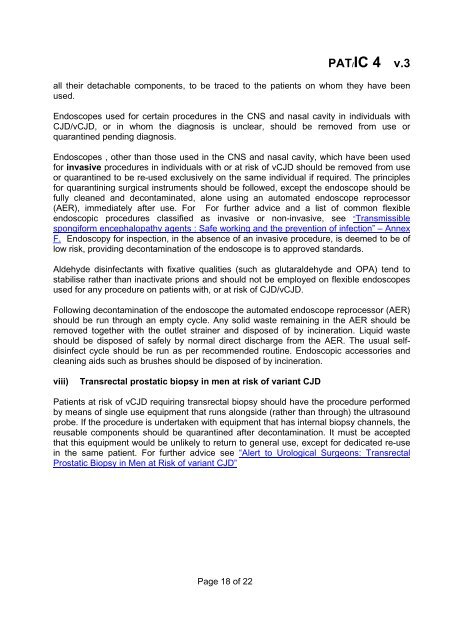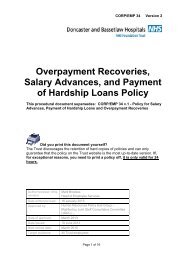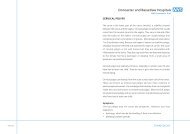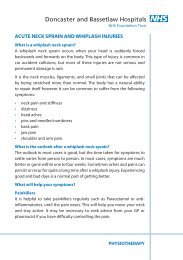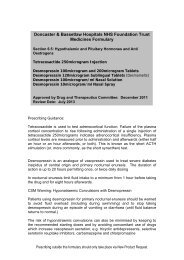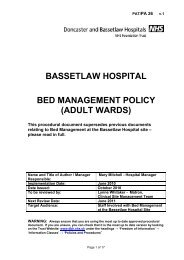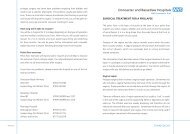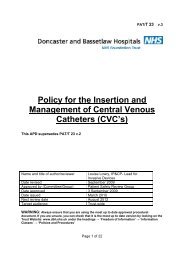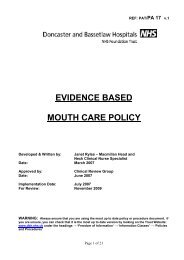VARIANT CREUTZFELDT-JAKOB DISEASE (vCJD) AND ...
VARIANT CREUTZFELDT-JAKOB DISEASE (vCJD) AND ...
VARIANT CREUTZFELDT-JAKOB DISEASE (vCJD) AND ...
Create successful ePaper yourself
Turn your PDF publications into a flip-book with our unique Google optimized e-Paper software.
PAT/IC 4 v.3<br />
all their detachable components, to be traced to the patients on whom they have been<br />
used.<br />
Endoscopes used for certain procedures in the CNS and nasal cavity in individuals with<br />
CJD/<strong>vCJD</strong>, or in whom the diagnosis is unclear, should be removed from use or<br />
quarantined pending diagnosis.<br />
Endoscopes , other than those used in the CNS and nasal cavity, which have been used<br />
for invasive procedures in individuals with or at risk of <strong>vCJD</strong> should be removed from use<br />
or quarantined to be re-used exclusively on the same individual if required. The principles<br />
for quarantining surgical instruments should be followed, except the endoscope should be<br />
fully cleaned and decontaminated, alone using an automated endoscope reprocessor<br />
(AER), immediately after use. For For further advice and a list of common flexible<br />
endoscopic procedures classified as invasive or non-invasive, see “Transmissible<br />
spongiform encephalopathy agents : Safe working and the prevention of infection” – Annex<br />
F. Endoscopy for inspection, in the absence of an invasive procedure, is deemed to be of<br />
low risk, providing decontamination of the endoscope is to approved standards.<br />
Aldehyde disinfectants with fixative qualities (such as glutaraldehyde and OPA) tend to<br />
stabilise rather than inactivate prions and should not be employed on flexible endoscopes<br />
used for any procedure on patients with, or at risk of CJD/<strong>vCJD</strong>.<br />
Following decontamination of the endoscope the automated endoscope reprocessor (AER)<br />
should be run through an empty cycle. Any solid waste remaining in the AER should be<br />
removed together with the outlet strainer and disposed of by incineration. Liquid waste<br />
should be disposed of safely by normal direct discharge from the AER. The usual selfdisinfect<br />
cycle should be run as per recommended routine. Endoscopic accessories and<br />
cleaning aids such as brushes should be disposed of by incineration.<br />
viii)<br />
Transrectal prostatic biopsy in men at risk of variant CJD<br />
Patients at risk of <strong>vCJD</strong> requiring transrectal biopsy should have the procedure performed<br />
by means of single use equipment that runs alongside (rather than through) the ultrasound<br />
probe. If the procedure is undertaken with equipment that has internal biopsy channels, the<br />
reusable components should be quarantined after decontamination. It must be accepted<br />
that this equipment would be unlikely to return to general use, except for dedicated re-use<br />
in the same patient. For further advice see “Alert to Urological Surgeons: Transrectal<br />
Prostatic Biopsy in Men at Risk of variant CJD”<br />
Page 18 of 22


